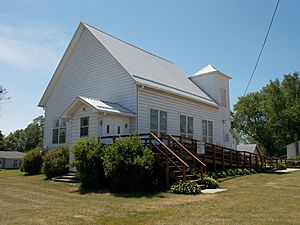Rochester, Iowa facts for kids
Quick facts for kids
Rochester, Iowa
|
|
|---|---|

Rochester United Methodist Church
|
|
| Country | United States |
| State | Iowa |
| County | Cedar |
| Area | |
| • Total | 0.98 sq mi (2.53 km2) |
| • Land | 0.95 sq mi (2.46 km2) |
| • Water | 0.02 sq mi (0.06 km2) |
| Elevation | 665 ft (203 m) |
| Population
(2020)
|
|
| • Total | 142 |
| • Density | 149.16/sq mi (57.61/km2) |
| Time zone | UTC-6 (Central (CST)) |
| • Summer (DST) | UTC-5 (CDT) |
| ZIP code |
52772
|
| FIPS code | 19-67890 |
| GNIS feature ID | 0460704 |
Rochester is a small community in Iowa, United States. It is located in Cedar County. It is called an "unincorporated community" because it does not have its own local government like a city. It is also a "census-designated place" (CDP), which means the government counts its population for official records.
In 2010, about 133 people lived in Rochester. By 2020, the population had grown slightly to 142 people.
A Look Back in Time
Rochester got its name from Rochester, New York. The original Rochester was famous for its flour mills. Our Rochester was named this because it is also located on a river, the Cedar River.
A long time ago, in 1902, only 53 people lived in Rochester.
Where is Rochester?
Rochester is in the eastern part of Iowa. It sits on the north bank of the Cedar River. This river flows through south-central Cedar County.
If you are traveling by car, County Road F44 crosses the river just south of Rochester. A major highway, Interstate 80, is about 2 miles (3.2 km) south of the community at Exit 265.
Nature's Treasure: Rochester Cemetery
One of the most interesting places in Rochester is the Rochester Cemetery. It is not just a place where people are buried. It is also one of the largest and most important cemetery prairies in the United States.
A cemetery prairie is a special type of land. It is a piece of original North American prairie that has been preserved. Most prairies in Iowa have been turned into farms or towns.
At Rochester Cemetery, you can find more than 350 different kinds of native American plants. Some of these plants are very rare. This makes the cemetery a unique place to study nature.
However, not everyone in the community agrees about how the cemetery should look. Some people think it looks too wild or "overgrown." Others really like its natural, wild prairie feel. They appreciate that it helps protect rare plants and shows what Iowa looked like long ago.
See also
 In Spanish: Rochester (Iowa) para niños
In Spanish: Rochester (Iowa) para niños


